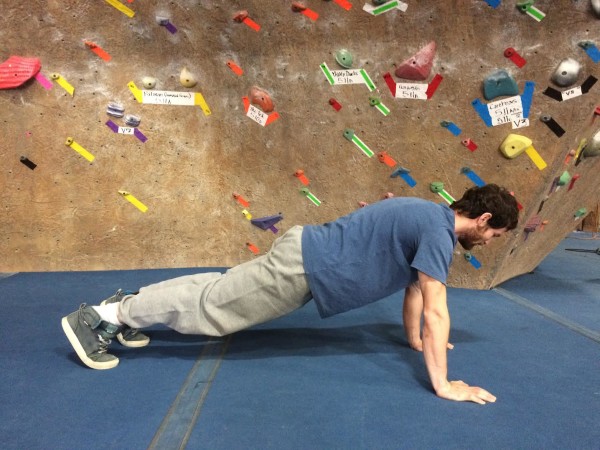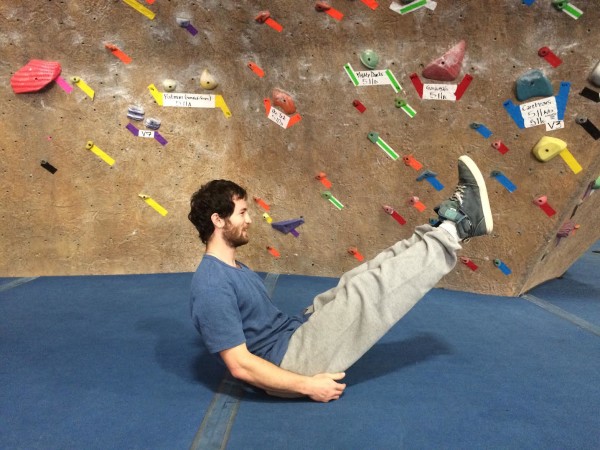I’ve been climbing for several years, but it was just recently that I actually learned how to use my core. If someone told me to “core up!” I honestly had no idea what they were talking about. The story of how I learned is slightly embarrassing, but if it’s for the betterment of rock climbing, I’ll spill.
A few years back, my friends and I were climbing in Ten Sleep, Wyoming. It was a pretty hot summer, and we spent most of the time with our shirts off (and before you go getting any ideas, yes, sports bras were worn by us girls). We noticed that some of us had little pooches in our lower bellies, especially when we sat down or bent over. As you all know, things tend to get pretty weird on climbing trips, and this trip was no exception. So, we all ended up giving names to our little beer guts. One of my friends lovingly named mine Bruhmhilda. Some of the other pooches’ names were Rasputia, Gus, and Matilda.
To be clear—this wasn’t some strange form of body hating or tummy shaming. This was an experience shared between a group of friends who had known each other for years and were comfortable (probably too comfortable) around each other. Anyway, one day I was climbing Killer Karma—probably the most overhanging route in Ten Sleep. It felt really, really hard. I was on huge jugs with good feet, but my butt was sagging down toward the ground. I tried to pull my hips in toward the wall, but it didn’t really feel like it was helping. All the sudden, I looked down and noticed something strange: Bruhmhilda was bigger than ever before. I know I had eaten a ton of pizza the night before, but she couldn’t have grown just from that. It was something about this body position and the movement that was causing her to pooch out even more than usual.
Looking back now, I know what happened—I wasn’t coring up. At least, not properly. I also used to think that Bruhmhilda, Gus, and all the other little beer bellies were made of fat, but that isn’t necessarily true. For most climbers and other healthy individuals with a strong core, that pooch is made up primarily of abdominal muscle. So how do we get our Bruhmhildas to work for us instead of against us? How do we core up?
Try this:
Get yourself into the classic Plank position, like you’re about to do a push-up. Make sure your hips aren’t sagging towards the floor or that your butt isn’t sticking up in the air. Now, notice what your belly is doing. Chances are, your core muscles are engaged or “flexed,” because this body position requires an activation of those muscles. But notice how your core is engaged. Is it sagging down or pooching out? Are the muscles creating a mini beer belly? If yes, the good news is that you have ab muscles, but the bad news is that they aren’t working at their full capacity.

Now try this:
Get back into Plank. Bring your awareness to your belly. Start to activate your core, but instead of flexing the muscles out and down toward the floor, draw your belly in toward your spine. Once you feel the sensation of pulling the muscles “in,” you can also work on drawing the muscles “up.” The “up” action might feel more subtle than the “in.” If you’re doing it right, your stomach will look flat (or, as flat as i’s gonna get!), and kind of feel like it’s hollowed out. Doing this action will help access and activate your deep core muscles, which are the ones we really need to be using when we’re climbing.
Taking it a step further …
After practicing coring up in a Plank position, take it a step further by trying the same exercise in a V-up position. Lay down on the floor face up, and bring your head, shoulders, and legs off the mat so you’re making a “V” shape with your body. Extend your arms parallel to the floor or above your head if you’re feeling strong. Now look down at your belly. Are your abs squishing out and making a little Bruhmhilda of your own? If so, don’t worry—it’s a lot harder to engage your deep core muscles in this position compared to Plank.

But look at the shape you’re body is taking. Isn’t it extremely similar to the position you’re in while climbing an overhang? So practice here: draw your core muscles in towards your spine and then slightly up as well. If you saw your belly move at all, you got it. With practice, you’ll soon be able to feel that “hollowed out” feeling much easier in this position.
A note on alignment:
Make sure you aren’t achieving this “in and up” action by squeezing your butt cheeks together or thrusting your hips forward. You should be able to do this without moving your hips at all. The movement should be secluded to your belly.
A few warnings:
I wouldn’t recommend trying this exercise if you’ve eaten in the past hour, if you’re menstruating, or if you have to pee really bad. I also wouldn’t recommend climbing anything too core-intensive if you’re dealing with any of those issues, either.
In conclusion …
The next time you do an ab/core workout, notice what your belly is doing. You can practice coring up in any position that requires ab engagement, not just the two positions that I’ve listed. Most importantly—keep all of this in mind while climbing! Start with a short boulder problem so you can get better at focusing on your core.
So, I know that you’ve been thinking up a great name for your pooch this entire time. Go ahead, give him/her a great name. Just don’t think that naming some random person’s stomach at the gym is going to score you a date. Good luck, and please contact me if you have any questions.
By: Georgie Abel
Georgie is a certified yoga teacher and offers private yoga consultations over Skype and in person for Bay Area residents. She has just released her first ebook called Modern Redpointing, which can be found here. Contact her if you want more information about yoga, climbing or coring up at [email protected].

